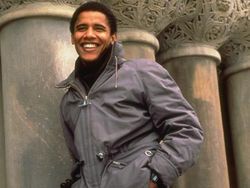Every year, we celebrate Black History Month by linking at least one relevant story every day. Along with Abbas, I am elated to end this unspeakably tragic journey on a high note which has restored the concept of the American Dream. Barack Obama summarized the unique potential that America offers to its citizens with eloquence: “My parents shared not only an improbable love, they shared an abiding faith in the possibilities of this nation. They would give me an African name, Barack, or blessed, believing that in a tolerant America your name is no barrier to success.” Barack Obama ZINDABAD!
From biography.com:
 President of the United States. Born Barack Hussein Obama on August 4, 1961, in Honolulu, Hawaii. Obama’s mother, Ann Dunham, grew up in Wichita, Kansas, where her father worked on oil rigs during the Depression. After the Japanese attack on Pearl Harbor, Dunham’s father, Stanley, enlisted in the service and marched across Europe in Patton’s army. Dunham’s mother, Madelyn, went to work on a bomber assembly line. After the war, the couple studied on the G.I. Bill, bought a house through the Federal Housing Program and, after several moves, landed in Hawaii. Obama’s father, Barack Obama, Sr., was born of Luo ethnicity in Nyanza Province, Kenya. The elder Obama grew up herding goats in Africa, eventually earning a scholarship that allowed him to leave Kenya and pursue his dreams of college in Hawaii. While studying at the University of Hawaii in Manoa, Obama, Sr. met fellow student, Ann Dunham. They married on February 2, 1961. Barack was born six months later.
President of the United States. Born Barack Hussein Obama on August 4, 1961, in Honolulu, Hawaii. Obama’s mother, Ann Dunham, grew up in Wichita, Kansas, where her father worked on oil rigs during the Depression. After the Japanese attack on Pearl Harbor, Dunham’s father, Stanley, enlisted in the service and marched across Europe in Patton’s army. Dunham’s mother, Madelyn, went to work on a bomber assembly line. After the war, the couple studied on the G.I. Bill, bought a house through the Federal Housing Program and, after several moves, landed in Hawaii. Obama’s father, Barack Obama, Sr., was born of Luo ethnicity in Nyanza Province, Kenya. The elder Obama grew up herding goats in Africa, eventually earning a scholarship that allowed him to leave Kenya and pursue his dreams of college in Hawaii. While studying at the University of Hawaii in Manoa, Obama, Sr. met fellow student, Ann Dunham. They married on February 2, 1961. Barack was born six months later.
 Obama’s parents separated when he was two years old, later divorcing. Obama, Sr. went on to Harvard to pursue Ph.D. studies, and then returned to Kenya in 1965. In 1966, Dunham married Lolo Soetoro, another East–West Center student from Indonesia. A year later, the family moved to Jakarta, Indonesia, where Obama’s half-sister Maya Soetoro Ng was born. Several incidents in Indonesia left Dunham afraid for her son’s safety and education so, at the age of 10, Barack was sent back to Hawaii to live with his maternal grandparents. His mother and sister later joined them.
Obama’s parents separated when he was two years old, later divorcing. Obama, Sr. went on to Harvard to pursue Ph.D. studies, and then returned to Kenya in 1965. In 1966, Dunham married Lolo Soetoro, another East–West Center student from Indonesia. A year later, the family moved to Jakarta, Indonesia, where Obama’s half-sister Maya Soetoro Ng was born. Several incidents in Indonesia left Dunham afraid for her son’s safety and education so, at the age of 10, Barack was sent back to Hawaii to live with his maternal grandparents. His mother and sister later joined them.
While living with his grandparents, Obama enrolled in the esteemed Punahou Academy, excelling in basketball and graduating with academic honors in 1979. As one of only three black students at the school, Obama became conscious of racism and what it meant to be African-American. He later described how he struggled to reconcile social perceptions of his multiracial heritage with his own sense of self. “I began to notice there was nobody like me in the Sears, Roebuck Christmas catalog…and that Santa was a white man,” he said. “I went to the bathroom and stood in front of the mirror with all my senses and limbs seemingly intact, looking the way I had always looked, and wondered if something was wrong with me.”
More here.
Shortly after I wrote an earlier piece on Bronner, pointing out that most Western coverage of the Israel-Palestine conflict is shaped by Jewish and Israeli journalists, and that Palestinian voices are almost entirely excluded, a Jerusalem-based bureau chief asked to meet. Over a coffee he congratulated me, adding: “I’d be fired if I wrote something like that.”
